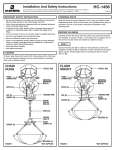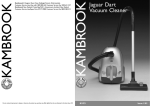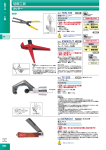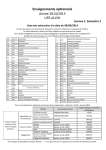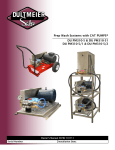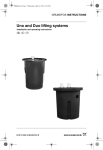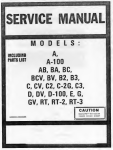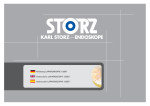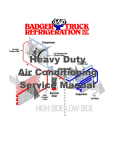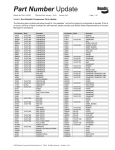Download Adaptaflex user guide A/W
Transcript
03/02 UK Icore/Entraco Santa Rosa, California USA cutting & assembly guide Adaptaflex Ltd Birmingham, England Tel: (707) 535-2700 Fax: (707) 566-2064 Tel: 06172 677314 Fax: 06172 677310 Adaptaflex GmbH Bad Homburg GERMANY Tel: (039) 544 4300 Fax: (039) 543 3614 Adaptaflex Pty. Oakleigh,Victoria AUSTRALIA Internet: www.adaptaflex.com Tel: 01675 468200 Fax: 01675 464930 agent details Flexible Conduit Systems LIT-038 Raising the Standard TYPE SP, SN & LFH-SP TYPE PA, PR, PI & PP LIQUID TIGHT COVERED STEEL FLEXIBLE SYSTEMS TYPE PA, P1 Cut-vice. (Between 16-40mm/3/8’’-11/4’’conduit). Adaptalok removal tool, all sizes. Swingcut. (Between 10 -32mm/1/4’’-1’’conduit). Kwikcut. (Up to 32mm/1’’ conduit). Rotocut. (20 & 25mm / 1/2’’ & 3/4’’ conduit). (not essential, but designed to speed up installation and available from Adaptaflex) Groove joint plier or adjustable spanner. TYPE SPLHCB HIGH STRENGTH OVERBRAIDED STEEL SYSTEM TYPE SB, STC, SPB & SPTC OVERBRAIDED STEEL FLEXIBLE SYSTEMS ADAPTASTEEL 8 Specialist Tools Fine tooth hacksawminimum 32 TPI. NON-METALLIC FLEXIBLE PVC SYSTEMS TYPE XF XF NON-METALLIC PLIABLE PVC SYSTEMS TYPE KF/KC KORIFIT 5 TYPE PK, PKTC, PKSS, PRTC & PRSS FLEXIBLE SYSTEMS HI-SPEC NON-METALLIC TYPE SPL, SPLHC & SPUL ADAPTASTEEL LARGE DIAMETER SYSTEMS 4 7 3 Tin snips. Junior hacksaw. Each page in this guide is numbered and colour coded in accordance with this contents list. Full technical details of each conduit system are given in the catalogue. COVERED STEEL FLEXIBLE SYSTEMS TYPE PA, PR, PI & PP ADAPTARING ADAPTASTEEL ADAPTASEAL Utility knife. Standard Hand Tools TOOLS REQUIRED The ‘Hints and Tips’ section on each page will give you a few ‘tricks of the trade’ to help you with your installation. How to assemble and securely fix the fitting to the conduit. Fitting Assembly Illustrations show you how to cut the conduit cleanly and accurately. Cutting the conduit Tools required to cut the conduit and assemble the fitting will be illustrated. The full range of tools is illustrated below. N.B. not all tools are applicable to all conduit Tools required The various Adaptaflex conduit system types, either non-metallic or metallic, are referenced here exactly as they are in our main product catalogue. TYPE S & SS STEEL FLEXIBLE SYSTEMS TYPE S & SS 2 ADAPTASTEEL TYPE PA, PR, PI & PP STEEL FLEXIBLE SYSTEMS Contents ADAPTALOK ADAPTASTEEL 6 1 Select the page Using the colour referenced index opposite choose the Adaptaflex conduit system you are to install. Turn to the appropriate section in this guide. On each page in the guide you will find an illustration of the conduit type and a typical fitting. METALLIC SYSTEMS NON-METALLIC SYSTEMS HOW TO USE THIS GUIDE Apply the tool over the conduit. Fitting Removal Offer up the fitting. Fitting Assembly Use the Kwikcut cutting tool, or Cutting the conduit Align with fitting lugs and push tool into fitting. Push and twist to ensure a firm fit and seal. Use a fine-tooth hacksaw, or utility knife. De-burr as necessary. • Kwikcut cutting tool, fine-tooth hacksaw, or utility knife. • Adaptalok removal tool to assist fitting removal. Tools required NON-METALLIC SYSTEMS 2 3 Holding the removal tool, pull the fitting from the conduit. Pull back the fitting to ensure fittings lugs have properly located in conduit groove. Ensure the cutting of the conduit is square and the cut remains in the ‘valley’ of the corrugation. Adaptalok fittings can also be removed by lifting the locking tabs with a small screwdriver and easing the fitting off the conduit. The seal accessory is only required if you want to upgrade performance from IP66 to IP67/8. nt i H Tips & s * IP rated to IP68 - 1.1 bar for 35 mins.Without the seal IP66 is achieved. 1) Angle seal approx. 30º and push one half to engage 2 ribs. 2) Push down on the ribs and feed the second half of the seal into the conduit. 3) Push conduit into Adaptalok as normal - see below. 1 NEW Adaptalok IP67 & IP68* Seal WITH TYPE PA, PR PI & PP CONDUITS ADAPTALOK 1 Use a fine-tooth hacksaw, or utility knife. De-burr as necessary. Fit sealing ring over conduit, ensuring the ribs seat in valley of the conduit, chamfered end of ring towards capnut. Apply capnut over end of the conduit. Fit ‘C-ring’ onto the conduit, chamfered end towards the capnut. Fitting Assembly ADAPTARING Apply the capnut over the end of the conduit. Fitting Assembly ADAPTASEAL Use the Kwikcut cutting tool, or Cutting the conduit • Kwikcut cutting tool, fine-tooth hacksaw, or utility knife. Tools required NON-METALLIC SYSTEMS Apply the fitting body up to the ‘C-ring’ and fully tighten by hand. Offer fitting body up to sealing ring and fully tighten capnut by hand. Before the body of the fitting is positioned, there should be three rings of the conduit visible after the seal or ‘C-ring’ is fitted. Fitting of on anti-vibration washer (type AWB), between capnut and body, will ensure integrity of assembled fitting. nt i H Tips & s WITH TYPE PA, PR, PI & PP CONDUITS ADAPTASEAL & ADAPTARING 2 Apply one half of clamp ring, ensuring ribs in clamp ring align. The straight flange fitting is assembled in a similar manner. Clamping ring ‘halves’ are aligned and clipped together. Fitting Assembly - straight flange Offer up the conduit into the fitting as far as the shoulder. The clamping ring can be removed with a screwdriver if required. Align the second half of the clamp ring and push click together. Fit the ‘O’ ring into the corresponding groove in the flange face. OPTIONAL SEALING KIT Locate the flat sealing washer in the first conduit corrugation and proceed as below. Fitting Assembly - 90° flange Securely clamp the conduit and cut using a fine tooth hacksaw or utility knife, in the valley of the corrugation. Cutting the conduit • Fine-tooth hacksaw Tools required NON-METALLIC SYSTEMS Ensure the cutting of the conduit is square and the cut remains in the ‘valley’ of the corrugation. Remove any excess burr from the cut conduit. nt i H Tips & s WITH TYPE PA, P1 CONDUITS LARGE DIAMETER SYSTEMS 3 Remove tape and pull back braided sheath. Apply inner capnut. Hand tighten body of fitting onto inner locknut. Offer up main body of fitting. Securely clamp the conduit preferably with a Cut-vice. Cut through the centre line of the tape. • Tin snips. • Adjustable grips or spanners. Apply the outer capnut over the braiding before removing tape. Fitting Assembly Apply insulating tape at the cutting point-2 revolutions recommended. Cutting the conduit • Fine-tooth hacksaw. • Cut vice. Tools required NON-METALLIC SYSTEMS Position braiding over inner locknut and secure with outer locknut. (Ensure braid is trapped between locknuts). Apply sealing ring - chamfered edge towards capnut, 3 corrugations in from end of conduit. Tighten components as shown. Use tin snips as required to trim the braiding after cutting with hacksaw. Other types of tape such as parcel tape, masking tape etc, can be used to facilitate cutting. nt i H Tips & s WITH TYPE PK, PKTC, PKSS, PRTC & PRSS CONDUITS HI-SPEC FLEXIBLE SYSTEMS 4 Use a fine-tooth hacksaw, or utility knife. De-burr as necessary. Apply capnut over conduit. Insert conduit into fitting between ‘barbs’ and inner shoulder. Fitting Assembly NEW XF fittings (13-32mm) Fully tighten the capnut by hand. Fit ‘C-ring’ onto the conduit, chamApply the fitting body up to the fered end towards the capnut, and ‘C-ring’ and fully tighten by hand. in the fourth corrugation groove. KORIFIT - push on fitting. Fitting assembly is as for Adaptalok fittings - see section 1. Apply capnut over end of the conduit. Fitting Assembly KORIFIT - 3 part fitting Use the Kwikcut cutting tool, or Cutting the conduit • Fine-tooth hacksaw. • Kwikcut cutting tool. Tools required NON-METALLIC PVC SYSTEMS When using push-on fittings with Korifit, use a push and twist action to ensure a good seal. nt i H Tips & s WITH TYPE XF CONDUIT NON-METALLIC FLEXIBLE PVC SYSTEMS XF WITH TYPE KF/KC CONDUITS NON-METALLIC PLIABLE PVC SYSTEMS KORIFIT 5 Use a Rotocut. Position and clamp conduit at position of required cut. • Adjustable grips or spanners. • Utility knife. Screw fitting through ferrule into conduit. Apply capnut then sealing ring chamfered end towards capnut. Screw insert into end of conduit. Fitting Assembly - type M Fit ferrule over end of conduit. Fitting Assembly - types A & B Securely clamp the conduit preferably with a Cut-vice - and use a fine tooth hacksaw, or Cutting the conduit • Fine-tooth hacksaw and Cut-vice • Rotocut. Tools required METALLIC SYSTEMS Offer up body and tighten capnut. Tighten with grips. As handle is turned, gently squeeze onto conduit to cut through spiral, then remove and twist to separate. Install and position fittings into desired threaded entry, then fully tighten the fitting. If using Rotocut with covered conduit, use a utility knife to cut through the pvc sheath. A clean, square cut will ease subsequent fitting assembly. nt i H Tips & s WITH TYPE SP, SN & LFH-SP CONDUITS COVERED STEEL FLEXIBLE SYSTEMS ADAPTASTEEL WITH TYPE S & SS CONDUITS STEEL FLEXIBLE SYSTEMS ADAPTASTEEL 6 Use a Swingcut. • Swingcut conduit cutter. • Adjustable grips or spanners. Offer up body of fitting and handtighten capnut. Apply capnut and sealing ring over conduit, ensuring chamfered edge of seal is towards fitting body. Fully screw the fitting into the conduit. Fitting Assembly - types A & B Push capnut then seal over conduit, screw in end fitting chamfered end towards capnut. Fitting Assembly - slim M type fittings Securely clamp the conduit preferably with a Cut-vice - and use a fine tooth hacksaw, or Cutting the conduit • Fine-tooth hacksaw. • Cut-vice conduit vice. Tools required METALLIC SYSTEMS Screw the capnut onto the fitting and tighten with grips or spanners as above. Install and position fittings into desired threaded entry, then fully tighten the fitting. For M type fitting, ensure liquid tight seal is applied as shown, with tapered side towards capnut. For fitting types A & B, seal is applied with chamfered side to fitting body. nt i H Tips & s WITH TYPE SPL, SPLHC & SPUL CONDUITS LIQUID TIGHT COVERED STEEL FLEXIBLE SYSTEMS ADAPTASTEEL 7 Securely clamp the conduit preferably with a Cut-vice. Cut through centre line of tape. • Tin snips. • Adjustable grips or spanners. Screw fitting body into conduit. Remove tape and pull back braiding to expose approx 50mm (2in) of conduit. Screw body of fitting into conduit. Before removing tape, place outer capnut onto conduit. Apply sealing ring with chamfer towards cut end of conduit. Fitting Assembly - for conduit type SPLHCB Remove tape, pinch braiding against inner conduit and apply ferrule. Fitting Assembly - conduit types SB, STC, SPB, & SPTC Apply insulating tape at the cutting point-2 revolutions recommended. Cutting the conduit • Fine tooth hacksaw. • Cut-vice. Tools required METALLIC SYSTEMS Screw inner nut onto fitting. Apply inner nut to seat under braiding. Tighten with grips or spanners. Screw outer nut onto inner nut ensuring braid is trapped securely and tighten with grips or spanners. Use tin snips as required to trim the braiding after cutting with hacksaw. Take care when pulling back the outer braiding. Due to the specialist nature of this conduit we offer a cutting and assembly service. Please ask for details. nt i H Tips & s WITH TYPE SPLHCB CONDUIT HIGH STRENGTH OVERBRAIDED STEEL SYSTEM WITH TYPE SB, STC, SPB & SPTC CONDUITS OVERBRAIDED STEEL FLEXIBLE SYSTEMS ADAPTASTEEL 8










